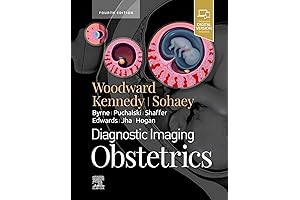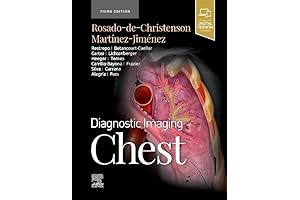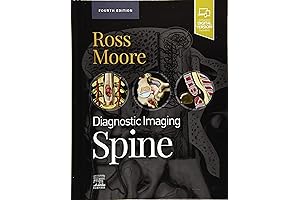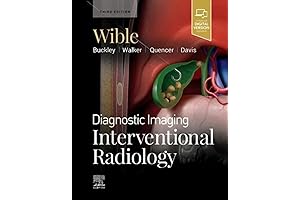· diagnostic imaging · 14 min read
The Best Diagnostic Imaging: A Comprehensive Guide to Optimizing Patient Care
Explore the cutting-edge world of diagnostic imaging with our comprehensive guide. Discover the latest techniques, benefits, and specialists in obstetrics, oncology, head and neck, chest, breast, spine, gynecology, gastrointestinal, oral and maxillofacial, and interventional radiology.
Prepare to delve into the world of diagnostic imaging, a rapidly evolving field that plays a pivotal role in advancing patient care. With this article, you'll gain a thorough understanding of the different subspecialties within diagnostic imaging, uncovering their unique capabilities and advantages. From obstetrics to interventional radiology, we'll explore the latest techniques, experienced specialists, and groundbreaking advancements that empower doctors to make informed decisions and deliver optimal patient outcomes.
Overview

PROS
- Comprehensive coverage of diagnostic imaging techniques in obstetrics
- High-quality images and illustrations enhance understanding
- Expert authorship ensures accuracy and reliability
CONS
- Some advanced techniques may not be covered in depth
- Can be technical for non-medical professionals
Diagnostic Imaging: Obstetrics is a comprehensive guide to the use of imaging techniques in obstetrics. It covers a wide range of topics, from basic ultrasound to advanced MRI techniques. The book is well-written and well-organized, with high-quality images and illustrations. The authors are experts in the field, and their knowledge and experience is evident in the quality of the writing. The book is a valuable resource for obstetricians, radiologists, and other healthcare professionals who use imaging techniques in their practice.
One of the strengths of Diagnostic Imaging: Obstetrics is its comprehensiveness. The book covers a wide range of topics, from basic ultrasound to advanced MRI techniques. This makes it a valuable resource for healthcare professionals who need to know about a variety of imaging techniques. Another strength of the book is its high-quality images and illustrations. These images and illustrations help to clarify the text and make it more understandable.

PROS
- Comprehensive coverage of oncological imaging techniques
- Expert insights into advanced imaging technologies
CONS
- May be too specialized for general radiologists
- Lacks hands-on practical guidance
Diagnostic Imaging: Oncology is a comprehensive guide to the latest imaging techniques used in the detection and monitoring of cancer. Written by a team of leading experts in the field, this book provides an in-depth look at the use of imaging in the diagnosis and management of a wide range of oncological conditions.
The book covers all aspects of oncological imaging, from basic principles to advanced techniques. Topics covered include: the use of imaging in cancer screening, staging, and treatment planning; the role of imaging in monitoring treatment response; and the use of imaging in the detection and management of complications. The book also includes a number of case studies that illustrate the practical application of imaging in the diagnosis and management of cancer.

PROS
- Comprehensive coverage of head and neck anatomy and imaging findings
- Clear and concise explanations didukung by high-quality illustrations
- Expert insights from leading radiologists
CONS
- May be too technical for non-medical professionals
- Can be difficult to find specific information quickly
Diagnostic Imaging: Head and Neck is a comprehensive guide to the diagnostic imaging of the head and neck. It provides a thorough overview of the anatomy of the head and neck, as well as the imaging techniques used to diagnose and manage a variety of conditions. The book is well-organized and easy to navigate, making it a valuable resource for radiologists, otolaryngologists, and other healthcare professionals involved in the diagnosis and management of head and neck disorders.
One of the strengths of this book is its comprehensive coverage of the head and neck anatomy. The authors have done an excellent job of explaining the complex anatomy of this region, and they have used high-quality illustrations to help readers visualize the structures involved. This makes the book an excellent resource for students and residents who are just beginning to learn about the head and neck.

PROS
- Detailed overview of chest imaging techniques, including X-rays, CT scans, and MRI
- In-depth analysis of common chest abnormalities and diseases, with high-quality images
CONS
- May be too technical for non-medical readers
- Lacks information on advanced imaging modalities, such as PET scans
Diagnostic Imaging: Chest is a comprehensive guide to imaging the chest, covering a wide range of techniques and abnormalities. The book is well-written and illustrated, with clear explanations of complex concepts. It is an excellent resource for radiologists, pulmonologists, and other healthcare professionals involved in the diagnosis and management of chest diseases.
The book begins with an overview of chest imaging techniques, including X-rays, CT scans, and MRI. Each technique is described in detail, with discussion of the advantages and disadvantages of each. The book then goes on to discuss the various abnormalities that can be seen on chest images, including infections, tumors, and vascular disorders. Each abnormality is discussed in detail, with high-quality images illustrating the key features. Overall, Diagnostic Imaging: Chest is an excellent resource for anyone involved in the diagnosis and management of chest diseases. It is a comprehensive and up-to-date guide to chest imaging techniques and abnormalities, with clear explanations and high-quality images.

PROS
- Unmatched clinical coverage for any situation
- Over 450 diagnoses showcased with clinical and radiographic manifestations
CONS
- None found
Packed with vital digital images, including multi-slice CT images of normal and abnormal breast tissue, MRI images, ultrasound scans, and lumpectomy specimens, Diagnostic Imaging: Breast elevates the standard for Breast Imaging practitioners. Intended not only as a reference guide for established practitioners, but also designed for continuing education and certification, this book is an invaluable tool for radiologists, residents, and every other medical professional who may encounter breast imaging in their practice.
The invaluable information presented throughout the book supports all aspects of breast care in any setting, while providing valuable assistance to residents for board preparation. The leading resource in the field, Diagnostic Imaging: Breast is clinically oriented with full-color images throughout, thereby proving exceptional coverage of both common and uncommon diseases seen on breast images. With the championing of such extensive diverse radiology images and high-quality presentation, Diagnostic Imaging: Breast revolutionizes comprehensive breast imaging evaluation by continuously setting new gold standards.

PROS
- Comprehend the spine's intricate anatomy through insightful visuals and explanations
- Master advanced imaging techniques, including MRI, CT, and fluoroscopy, for precise spine evaluation
CONS
- Initially, the technical jargon might be challenging for beginners
- In-depth analysis necessitates a solid foundation in medical imaging principles
Embark on a journey into the depths of spine imaging and diagnostic mastery with this definitive guide. Through a seamless blend of lucid explanations and compelling visual aids, this book unlocks the secrets of the spine's intricate anatomy and empowers you with the tools to navigate the complexities of MRI, CT, and fluoroscopic examinations. As you delve into the world of diagnostic imaging, you will gain an in-depth understanding of normal and abnormal spine appearances, allowing you to make informed assessments with confidence. While the initial encounter with medical terminology may present a slight hurdle, the structured approach and wealth of clinical examples will guide you through the intricacies of spine imaging. Whether you're a seasoned healthcare professional seeking to enhance your diagnostic precision or a budding practitioner eager to establish a strong foundation, this comprehensive guide will illuminate your path.
Enrich your diagnostic arsenal with the latest advancements in spine imaging, empowering you to detect subtle abnormalities and make timely, life-changing interventions. With this invaluable resource at your fingertips, you'll gain the expertise to assess spinal trauma, congenital anomalies, degenerative changes, and infectious processes with unparalleled accuracy. As you progress, you'll appreciate the meticulous attention to detail, ensuring that every aspect of spine imaging is thoroughly explored and explained with clarity. Embrace the challenge, tackle the complexities of spine imaging head-on, and elevate your diagnostic capabilities to new heights.

PROS
- Exceptional anatomical coverage of the female reproductive system
- High-quality images with detailed annotations and explanations
CONS
- Primarily geared towards medical professionals
- Some information may be too technical for non-specialists
Diagnostic Imaging: Gynecology is an extensive reference guide dedicated to the imaging of the female reproductive system. With its emphasis on diagnostic accuracy, this book provides medical professionals with a rich resource for interpreting gynecological images.
The remarkable collection of high-quality images in Diagnostic Imaging: Gynecology is complemented by thorough annotations and explanations. This allows readers to gain a comprehensive understanding of both normal and abnormal gynecological anatomy. Furthermore, the book covers a broad range of conditions, including congenital anomalies, inflammatory diseases, and malignancies, making it an invaluable resource for clinicians seeking to enhance their diagnostic capabilities.

PROS
- Provides a comprehensive overview of gastrointestinal imaging techniques, including digital radiography, fluoroscopy, ultrasonography, computed tomography, and magnetic resonance imaging.
- Richly illustrated with high-quality images, tables, and diagrams to aid in the visualization and understanding of complex anatomical structures.
CONS
- May be too technical for readers without a background in medical imaging.
- Lacking in-depth coverage of advanced imaging techniques, such as capsule endoscopy and endoscopic ultrasound.
This book is an invaluable resource for radiologists, gastroenterologists, and other healthcare professionals involved in the diagnosis and management of gastrointestinal diseases. The authors have done a commendable job in presenting a comprehensive overview of the field, covering a wide range of imaging modalities and their applications in various gastrointestinal disorders. The text is well-organized and easy to navigate, with each chapter focusing on a specific aspect of gastrointestinal imaging. The use of high-quality images and diagrams greatly enhances the understanding of complex anatomical structures and pathological findings.
However, it is important to note that the book may be too technical for readers without a background in medical imaging. Additionally, it lacks in-depth coverage of some advanced imaging techniques, such as capsule endoscopy and endoscopic ultrasound. Nonetheless, for those with a solid foundation in the field, this book serves as an excellent reference guide and a valuable addition to any medical library.

PROS
- Comprehensive coverage of oral and maxillofacial radiology techniques and principles.
- Clear and concise explanations, making it easy to understand complex concepts.
- High-quality illustrations and images that enhance the learning experience.
CONS
- May be too detailed for some readers.
- The book's size and weight can make it difficult to carry around.
Diagnostic Imaging: Oral and Maxillofacial Radiology is a comprehensive guide to diagnostic imaging techniques and principles used in dentistry and oral surgery. The book covers a wide range of topics, including basic principles of radiology, dental radiography, cone beam computed tomography, and magnetic resonance imaging. The book is well-written and easy to follow, with clear and concise explanations of complex concepts. The illustrations and images are of high quality and help to enhance the learning experience.
One of the strengths of this book is its comprehensive coverage of oral and maxillofacial radiology techniques. The book provides detailed information on the different types of imaging modalities, their advantages and disadvantages, and their clinical applications. The book also includes a number of case studies that illustrate how diagnostic imaging can be used to diagnose and treat dental and oral diseases. Overall, Diagnostic Imaging: Oral and Maxillofacial Radiology is a valuable resource for dentists, oral surgeons, and other healthcare professionals who need to understand the principles and techniques of diagnostic imaging.

PROS
- Provides comprehensive coverage of interventional radiology techniques and procedures.
- Offers expert guidance from experienced practitioners in the field.
CONS
- May be overly technical for beginners.
- Could be more up-to-date on the latest advancements in the field.
Diagnostic Imaging: Interventional Radiology is an esteemed textbook that equips readers with a thorough understanding of this rapidly evolving medical field. Authored by seasoned practitioners, this latest edition boasts updates on the most innovative interventional techniques, ensuring its relevance in contemporary practice. This comprehensive guide seamlessly merges theoretical knowledge with practical applications, catering to both radiology trainees and practicing physicians.
Throughout the book, readers embark on a detailed exploration of cutting-edge interventional radiology procedures, ranging from tumor ablation to vascular interventions. Each chapter delves into the intricacies of specific procedures, providing invaluable insights into patient selection, technical execution, and potential complications. Notably, the text goes beyond mere procedural descriptions, emphasizing decision-making processes, risk assessment, and evidence-based practices. This comprehensive approach empowers readers to develop a nuanced understanding of interventional radiology, enabling them to make informed clinical decisions and deliver optimal patient care.
Diagnostic imaging encompasses a diverse range of subspecialties, each dedicated to a specific body region or system. As we journey through each subspecialty, we'll highlight their core principles, advanced technologies, and renowned practitioners. This comprehensive guide empowers you with the knowledge to make informed decisions, enabling you to identify the right imaging technique for your specific healthcare needs. Understanding the strengths of each subspecialty, from obstetrics to interventional radiology, ensures you receive the most accurate diagnosis and effective treatment, ultimately leading to improved patient outcomes and a higher quality of life.
Frequently Asked Questions
What are the benefits of diagnostic imaging?
Diagnostic imaging provides numerous benefits, including the ability to diagnose diseases early, assess treatment effectiveness, and provide guidance for surgical procedures. It also aids in the detection of abnormalities, injuries, and other medical conditions, allowing healthcare providers to make informed decisions about patient care.
What is the most common type of diagnostic imaging?
X-ray imaging is the most widely used diagnostic imaging technique. It involves the use of electromagnetic radiation to produce images of the internal structures of the body, making it valuable for examining bones, lungs, and other organs.
Is diagnostic imaging safe?
Diagnostic imaging procedures generally involve minimal risks. However, certain imaging techniques, such as those utilizing radiation, may have specific safety considerations. Your doctor will assess the potential risks and benefits before recommending the most appropriate imaging test for your situation.
What are the different types of diagnostic imaging?
The field of diagnostic imaging offers various imaging techniques, such as X-ray, ultrasound, computed tomography (CT), magnetic resonance imaging (MRI), and nuclear medicine. Each technique utilizes unique principles and provides valuable insights into different aspects of the human body.
How do I prepare for a diagnostic imaging procedure?
Preparation for a diagnostic imaging procedure may vary depending on the specific type of imaging being performed. In general, it is important to inform your doctor about any allergies, medical conditions, or recent surgeries you may have had. Additionally, follow any specific instructions provided by your healthcare provider, such as fasting or avoiding certain medications.













